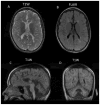Quantitative neuroimaging in mucolipidosis type IV
- PMID: 24332805
- PMCID: PMC4097300
- DOI: 10.1016/j.ymgme.2013.11.007
Quantitative neuroimaging in mucolipidosis type IV
Abstract
Mucolipidosis type IV (MLIV) is an autosomal recessive disorder resulting from mutations in the MCOLN1 gene. This gene encodes the endosomal/lysosomal transient receptor potential channel protein mucolipin-1 (TRPML1). Affected patients suffer from neurodevelopmental abnormalities and progressive retinal dystrophy. In a prospective natural history study we hypothesized the presence of an additional slow cerebral neurodegenerative process. We have recruited 5 patients, tested their neurodevelopmental status, and measured cerebral regional volumes and white matter integrity using MRI yearly. Over a period of up to 3 years, MLIV patients remained neurologically stable. There was a trend for increased cortical and subcortical gray matter volumes and increased ventricular size, while white matter and cerebellar volumes decreased. Mean diffusivity (MD) was increased and fractional anisotropy (FA) values were below normal in all analyzed brain regions. There was a positive correlation between motor scores of the Vineland Scale and the FA values in the corticospinal tract (corr coef 0.39), and a negative correlation with the MD values (corr coef -0.50) in the same brain region. We conclude from these initial findings that deficiency in mucolipin-1 affects the entire brain but that there might be a selective regional cerebral neurodegenerative process in MLIV. In addition, these data suggest that diffusion-weighted imaging might be a good biomarker for following patients with MLIV. Therefore, our findings may be helpful for designing future clinical trials.
Keywords: Lysosomal disorder; Mucolipidosis; Natural history; Volumetry.
Copyright © 2013 Elsevier Inc. All rights reserved.
Figures


Similar articles
-
Early evidence of delayed oligodendrocyte maturation in the mouse model of mucolipidosis type IV.Dis Model Mech. 2020 Jul 30;13(7):dmm044230. doi: 10.1242/dmm.044230. Dis Model Mech. 2020. PMID: 32586947 Free PMC article.
-
N-butyldeoxynojirimycin delays motor deficits, cerebellar microgliosis, and Purkinje cell loss in a mouse model of mucolipidosis type IV.Neurobiol Dis. 2017 Sep;105:257-270. doi: 10.1016/j.nbd.2017.06.003. Epub 2017 Jun 10. Neurobiol Dis. 2017. PMID: 28610891 Free PMC article.
-
The neurogenetics of mucolipidosis type IV.Neurology. 2002 Aug 13;59(3):306-13. doi: 10.1212/wnl.59.3.306. Neurology. 2002. PMID: 12182165
-
The molecular basis of mucolipidosis type IV.Curr Mol Med. 2002 Aug;2(5):445-50. doi: 10.2174/1566524023362276. Curr Mol Med. 2002. PMID: 12125810 Review.
-
Mucolipidosis type IV: an update.Mol Genet Metab. 2011 Nov;104(3):206-13. doi: 10.1016/j.ymgme.2011.06.006. Epub 2011 Jun 16. Mol Genet Metab. 2011. PMID: 21763169 Free PMC article. Review.
Cited by
-
Brain cell type specific proteomics approach to discover pathological mechanisms in the childhood CNS disorder mucolipidosis type IV.Front Mol Neurosci. 2023 Aug 7;16:1215425. doi: 10.3389/fnmol.2023.1215425. eCollection 2023. Front Mol Neurosci. 2023. PMID: 37609073 Free PMC article.
-
Cognitive Development in a Young Child with Mucolipidosis Type IV: A Case Report.JIMD Rep. 2017;35:97-103. doi: 10.1007/8904_2016_31. Epub 2017 Jan 3. JIMD Rep. 2017. PMID: 28044261 Free PMC article.
-
Peripheral Inflammatory Cytokine Signature Mirrors Motor Deficits in Mucolipidosis IV.Cells. 2022 Feb 4;11(3):546. doi: 10.3390/cells11030546. Cells. 2022. PMID: 35159355 Free PMC article.
-
Pre-clinical Mouse Models of Neurodegenerative Lysosomal Storage Diseases.Front Mol Biosci. 2020 Apr 15;7:57. doi: 10.3389/fmolb.2020.00057. eCollection 2020. Front Mol Biosci. 2020. PMID: 32351971 Free PMC article. Review.
-
Current concepts in the neuropathogenesis of mucolipidosis type IV.J Neurochem. 2019 Mar;148(5):669-689. doi: 10.1111/jnc.14462. Epub 2018 Aug 30. J Neurochem. 2019. PMID: 29770442 Free PMC article. Review.
References
-
- Altarescu G, Sun M, Moore DF, Smith JA, Wiggs EA, Solomon BI, Patronas NJ, Frei KP, Gupta S, Kaneski CR, Quarrell OW, Slaugenhaupt SA, Goldin E, Schiffmann R. The neurogenetics of mucolipidosis type IV. Neurology. 2002;59:306–313. - PubMed
-
- Sun M, Goldin E, Stahl S, Falardeau JL, Kennedy JC, Acierno JS, Jr, Bove C, Kaneski CR, Nagle J, Bromley MC, Colman M, Schiffmann R, Slaugenhaupt SA. Mucolipidosis type IV is caused by mutations in a gene encoding a novel transient receptor potential channel. Hum Mol Genet. 2000;9:2471–2478. - PubMed
-
- Goldin E, Slaugenhaupt SA, Smith JA, Schiffmann R. Mucolipidosis type IV. In: Scriver CR, Beaudet AL, Valle D, Sly WS, Vogelstein B, Childs B, Kinzler KW, editors. Metabolic and Molecular Bases of Inherited Diseases. McGraw-Hill; 2005.
-
- Amir N, Zlotogora J, Bach G. Mucolipidosis type IV: clinical spectrum and natural history. Pediatrics. 1987;79:953–959. - PubMed
Publication types
MeSH terms
Grants and funding
LinkOut - more resources
Full Text Sources
Other Literature Sources
Molecular Biology Databases

